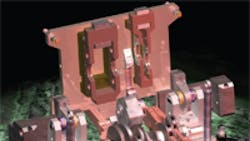Over the past three decades induction has become an increasingly popular choice for heating steel billets prior to forging, due to its ability to create high heat intensity quickly and within a billet. That ability leads to low process-cycle time (high productivity) with repeatable high quality, occupying minimal space on the shop floor.
The various considerations that contribute to success in induction heating were detailed by Dr. Valery Rudnev, Induction Heat Group; Doug Brown, Inductoheat Inc.; and Dr. Chester J. Van Tyne, and Dr. Kester D. Clarke, both of the Colorado School of Mines in a paper they presented last fall at the 2008 International Forging Congress — “Intricacies for the Successful Induction Heating of Steels in Modern Forge Shops.”
According to the authors, induction heating is attractive because it is more energy-efficient and inherently more environmentally friendly than most other heat sources for steel billets. Other advantages include 1) a noticeable reduction of scale, 2) short start-up and shut-down times, 3) readiness for automation with lower labor cost, and 4) ability to heat in a protective atmosphere if required.”
Heating approaches — Progressive and static heating are the two basic approaches to induction billet heating.
In progressive, multistage horizontal heating, billets are moved via pusher or indexing mechanism through a single coil or multi-coil horizontal induction heater. Each billet is progressively heated at predetermined positions inside of the induction heater.
In static heating, a billet is placed into an induction coil for a given period of time while a set amount of power is applied until it reaches the desired heating conditions. When the heating cycle is completed, the control system checks whether the press is ready to accept the billet. If it is not completed, the inductor mode changes from heating to holding.
The selection of power, frequency, and coil length in induction billet heating applications is highly subjective, depending upon the type of metal being heated, required temperature uniformity, billet size, etc. Depending upon the application, power levels from hundreds to thousands of kilowatts and frequencies from 60 Hz to 10 kHz are commonly used for induction billet heating.
Heating temperatures — The selection of forging temperatures for plain carbon and alloy steels is based upon four major factors: (1) carbon content, (2) alloy composition, (3) the temperature range for optimum plasticity (maximum forgeability), and (4) the amount of reduction. Based upon these four considerations, forging temperatures are selected such that the material has the lowest possible flow stress (and therefore lowest possible forging pressure.)
Recommended forging temperatures are approximately 300°F below the solidus temperature for plain carbon steels and an additional 50-100°F lower for alloy steels. Above these temperatures the steels are subject to possible damage by incipient melting or overheating.
The authors point out that it is typically required not only to raise the billet’s temperature to a specified level, but also to provide a certain degree of heat uniformity. The uniformity requirement may include maximum tolerable thermal gradients: “surface-to-core,” “end-to-end,” and “side-to-side.”
Positioning and magnitude of the maximum temperature within the heated billet is a complex function of four factors: frequency, refractory, final temperature, and the power distribution along the heating line.
Lower frequency results in more “in-depth” heating, leading to a faster heating of a billet’s internal areas and its core. This shortens the induction line, but it may also increase the maximum of the subsurface temperature and shifts its position further away from the surface.
The use of an appreciably thick refractory with lower thermal conductivity does just the opposite, reducing subsurface over-heating and shifting it toward the billet’s surface.
Requiring higher final temperatures results in an effect similar to lowering frequency on positioning and magnitude of the maximum temperature.
Heating design — A common approach to the design of a heating line is a single power supply for several coils, with a graded number of turns and/or series/parallel coil circuit connection. Putting more power up-front might sound like a “rule of thumb” because it forces more energy into the billet at the front of the heating line, giving it more time to soak into the core of the billet. The temperature at the billet’s center can reach the forging temperature in a shorter period of time, reducing the length of the coil line.
The problem with this type of design, the authors cautioned, is that the power distribution along the heating line cannot be modified easily if the production rate changes. For example, if the production rate is reduced, a subsurface overheating problem worsens and could negatively affect the billet’s subsurface microstructure.
It is also very common to find billetsticking problems with graded coils. This occurs when the system runs at a rate slower than the maximum for which it is designed. Because the system puts more energy into the billet in the first coils, too much energy soaks down into billet’s subsurface area when the line runs slow.
To optimize induction heating performance, improve product quality, and avoid unpleasant surprises related to subsurface overheating, it is imperative that an induction system be capable of redistributing power along the line while heating billets of different sizes and production rates.
When heating large billets at nominal rates, more power should be shifted toward the beginning of induction line. At slower rates, however, when heating smaller than nominal size billets, power should be shifted toward the end of the induction line.
Hardening/Tempering System for Crankshafts
Inductoheat Inc. reports it recently shipped four CrankPro systems to several leading suppliers of automobile crankshafts. CrankPro system is a “non-rotational induction hardening and tempering machine” that uses SHarP-C technology, which eliminates the rotation of the crankshaft and movement of the inductor during heating and quenching cycles.
This stationary technique provides crankshaft producers with several practical and technical benefits: reduced floor space; robust machined coils; low part distortion; and minimal part growth. In addition, it operates with short heat times (<3 secs) and high production rates (up to 120 parts/per hour.).
